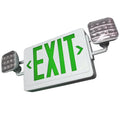
Letter Color Green Exit Signs Combo
Designed to maintain illuminated egress when building power fails.

Shop battery backup exit sign combos—all-in-one fixtures that pair an illuminated EXIT legend with integrated emergency lamp heads. These exit sign and emergency light combos provide at least 90 minutes of illumination during power loss to meet UL 924, support NFPA 101, and aid OSHA compliance. For automated maintenance, see self-testing exit sign combo units.
Each combo includes an LED EXIT faceplate (red or green), field-selectable chevrons, and adjustable emergency heads driven by a shared internal battery and solid-state charger/transfer circuit. This unified design simplifies installation and service while maintaining required light levels along paths of egress in stairwells, corridors, and utility spaces.
Most models ship with universal mounting hardware for wall, ceiling, or end installations and offer single- or double-face configurations. For outdoor or wash-down areas, choose wet-location exit sign and emergency light combos; for harsh industrial environments, consider sealed NEMA-rated emergency lights.
Self-testing availability and temperature ratings vary by model—confirm diagnostics, runtime, and accessories on the product specification sheet.
28 Products
An exit sign combo combines an illuminated EXIT legend with integrated emergency lamp heads, delivering both signage and egress lighting from a single fixture to save space and simplify wiring.
A built-in rechargeable battery powers the EXIT panel and the emergency heads during an outage, providing at least 90 minutes of illumination to meet UL 924 and support NFPA 101.
Yes. Combos are UL listed for emergency egress and are designed to satisfy national life-safety codes and typical IBC/OSHA expectations when installed per spec.
Common locations include corridors, stairwells, exit doors, and other key egress points in commercial, educational, healthcare, and industrial buildings.
Most models use Ni-Cd or LiFePO4 (lithium) packs with solid-state charging and automatic transfer. Verify chemistry, ambient temperature ratings, and recharge time on the spec sheet.
Test monthly for at least 30 seconds and annually for the full 90-minute duration. Most units include a test button and status LED to simplify checks.
Typical service life is 3–5 years depending on chemistry and environment. Routine testing helps identify when repl